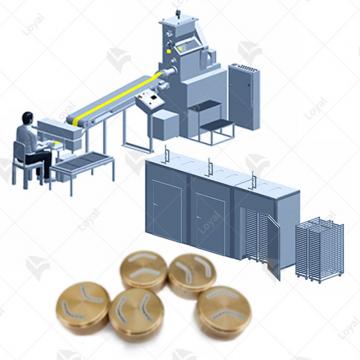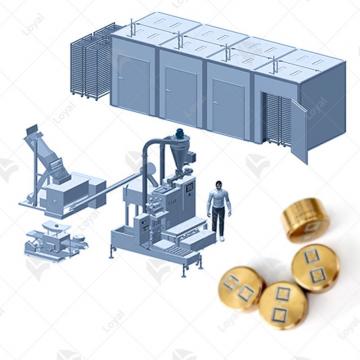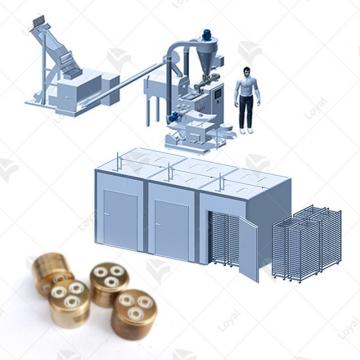
- Shandong Loyal Industrial Co.,Ltd.
- SHORT-CUT PASTA PRODUCTION LINE LONG-CUT PASTA PRODUCTION LINE INSTANT PASTA PRODUCTION LINE
The Combined Pasta Production Line and Its Transformative Capabilities
In the ever-evolving landscape of pasta production, the Combined Pasta Production Line emerges as a technological marvel, seamlessly integrating efficiency, versatility, and precision. This comprehensive exploration delves into the intricacies of the Combined Pasta Production Line, encompassing its working principles, distinctive features, varied applications, and market implications. This innovative solution caters to the demands of both long-cut and short-cut pasta production, offering a holistic approach to modern pasta manufacturing.
Understanding the Combined Pasta Production Line:
The Combined Pasta Production Line represents a sophisticated integration of machinery and technology designed to streamline the pasta manufacturing process. At its core, this line combines the capabilities of long-cut and short-cut pasta production, offering manufacturers the flexibility to produce an extensive range of pasta shapes and sizes. The key component of this line is the Combined Pasta Machine, which includes features such as the Combined Automatic Pasta Sheeter.
Working Principles of the Combined Pasta Machine:
a. Long-Cut Pasta Production Line:
The long-cut pasta production aspect of the Combined Pasta Machine involves a systematic process. Initially, durum wheat semolina or other flour varieties are mixed with water to form a dough. This dough is then fed into the machine's extruder, where it undergoes shaping processes to create long strands of pasta, such as spaghetti or fettuccine.
b. Short-Cut Pasta Production Line:
Simultaneously, the short-cut pasta production process takes place within the same machine. The dough is processed differently to create various shapes, including penne, fusilli, or macaroni. The Combined Pasta Machine is equipped with specialized dies and cutting mechanisms to achieve precision in shaping short-cut pasta.
c. Combined Automatic Pasta Sheeter:
The Automatic Pasta Sheeter component of the machine plays a crucial role in ensuring uniform thickness throughout the pasta production process. It facilitates the rolling and sheeting of pasta dough, contributing to the consistency and quality of both long-cut and short-cut pasta varieties.
Key Features of the Combined Pasta Machine:
i. Versatility: The ability to produce both long-cut and short-cut pasta within the same machine makes it highly versatile, catering to diverse consumer preferences.
ii. Precision:The Combined Pasta Machine incorporates advanced technologies for extrusion, cutting, and sheeting, ensuring precision in the creation of various pasta shapes.
iii. Efficiency:The automation of processes, including the Automatic Pasta Sheeter, enhances overall production efficiency, reducing labor requirements and increasing output.
iv. Customization: Manufacturers can easily adjust parameters to customize pasta shapes and sizes, adapting to market trends and consumer demands.
COMBINED PASTA PRODUCTION LINE
Contact Now-

Combined Automatic Pasta Sheeter
-
The combined automatic pasta sheeter is designed to provide efficient and reliable short-cut pasta production line for commercial and industrial applications. These long-cut pasta...
-

Combined Pasta Machine
-
Full automatic and semi automatic combined pasta production lines produced for whole day and various type of production capacity in an hour like 100 kg/h, 200 kg/h, 300 kg/h, 400 kg/h, 500 kg/h,...
-

Combined Pasta Production Line
-
Combined pasta production line main purpose is provide high quality product with low investment price. Using latest and newest technology, which it can build-up or redesign your...
Market Implications and Future Trends:
As consumer preferences continue to evolve, the Combined Pasta Production Line addresses the demand for variety and convenience in pasta offerings. The ability to produce multiple pasta shapes within a single line aligns with the trend of diversification in the pasta market. Manufacturers embracing this technology position themselves strategically to cater to a broader consumer base.
Furthermore, the integration of automation and customization features in the Combined Pasta Machine aligns with the broader trend in the food industry toward smart manufacturing and sustainable practices. The efficiency gains and reduced waste associated with this technology contribute to a more environmentally conscious approach to pasta production.
In conclusion, the Combined Pasta Production Line, with its innovative machine and advanced features, embodies the future of pasta manufacturing. Its adaptability, precision, and efficiency make it a cornerstone for both established pasta producers and newcomers seeking to make their mark in the dynamic and ever-expanding world of pasta production. As the industry continues to evolve, the Combined Pasta Production Line stands as a beacon of progress, reshaping the way pasta is made and enjoyed around the globe.
Applications of the Combined Pasta Production Line:
The Combined Pasta Production Line finds applications in a multitude of settings within the pasta manufacturing industry. From large-scale industrial operations to smaller artisanal producers, the versatility of this line caters to a wide spectrum of needs. Its capability to produce both long-cut and short-cut pasta varieties positions it as a go-to solution for those seeking flexibility and efficiency in their pasta production processes.
Questions and Answers
Q: Guarantee?
A: Within 12 months.
Q: How long is your delivery time?
A: Generally it is 5-10 days if the goods are in stock. Or it is 30-40 days if the goods are not in stock, it is according to quantity.
Q: How is it transported?
A:For ocean freight, our port of origin is QINGDAO PORT, CHINA.
Q:How do we install the machine?
A: We will send 1-2 enginners to the buyer’s factory for a 15-20day period installation and training to the operators.
Q: What is your terms of payment?
A: 40% is paid by T/T as the down payment, 60% is paid by T/T or L/C before shipment.
